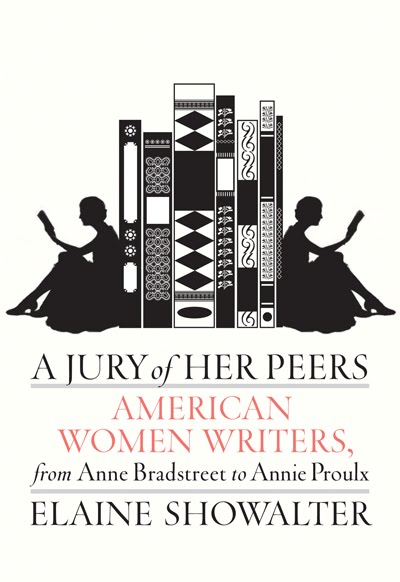When I finished writing A Jury of Her Peers, I checked through and discovered that I had discussed women writers from every state except Montana. Montana didn't seem to have many women writers to choose from. In the early 20th century, Bertha Muzzy Bower (1871-1940) published sixty-eight popular novels set in the Old West. A few more contemporary writers, including the poet Patricia Goedicke, passed through Montana while they were teaching creative writing at the university. Anyway, I left Montana open.
Now I can fill that space. I had read the remarkable short story "Wild Plums," published in 1929 by Grace Stone Coates, in John Updike's anthology Best American Short Stories of the Century, in 1999, but I had forgotten it. Rediscovering Coates's name in Montana Women Writers: A Geography of the Heart (2006), I ordered a copy of the collection in which "Wild Plums" had first appeared, Black Cherries, reprinted by the University of Nebraska Press (2003), with a very good introduction by Mary Clearman Blew.

The life of Grace Stone Coates ( 1881-1976) is both sad and paradigmatic. She was born on a Kansas wheat farm to Heinrich and Olive Sabrina Stone, on whom the unhappy parents in the stories of Black Cherries are clearly based. Heinrich Stone was a gambler and speculator in farming equipment, and often travelled, leaving his family behind. Grace managed to get a year at the University of Chicago. When her mother died in 1904, she went to Butte, Montana with her sister Helen, and taught school for six years. In 1910,l she married Henderson Coates, and moved with him to the small ranching community of Martinsdale, Montana where he kept a general store. She lived there until 1962, when she moved to a retirement home in Bozeman..
The couple did not have children and for many years Grace found the harsh environment an “alien land.” She spent some time in the Mayo Clinic for nervous disorders. But she also published a poem about the loneliness of the West in Poetry in 1922, and during the 1920s, other poems followed. She took a correspondence course from the University of Chicago and wrote the first of her autobiographical stories about a little girl, Veve (Genevieve) growing up within a sexually troubled and secretive family. Then in 1927, she met H.G. Merriam, an extraordinarily gifted and visionary English professor at the University of Montana, who had come there to start a creative writing program. Merriam was also starting up a literary journal, The Frontier, and asked her to become the assistant editor. Coates’s opportunity to work with the brilliant and cosmopolitan Merriam (he had been a Rhodes Scholar at Oxford) , and to make contact with a literary community, was a marvelous creative impetus and rebirth. During the next seven years, she published more than 100 poems and short stories, and two books of poetry. In 1929, her story “Wild Plums” was selected by Edward O’Brien for his collection of the best short stories of the year.
Merriam encouraged her to revise and put together several of her autobiographical short stories and send them to New York publishers. Coates found the project very difficult. “Trying to rearrange these stories,” she wrote to him, “is like rebuilding an old house, changing one thing throws something else out of kilter.” But Knopf accepted Black Cherries and published it as a novel in 1931. After the publication of Black Cherries he urged her to write a second novel: “Of you are to continue as a writer—and you must do so—it is time that another book by you should appear.” But she could not make the transition to being a professional writer. During 1935, she finished a manuscript called Clear Title, which she described to Merriam as another novel closely based on her family history. Knopf turned it down, “questioning its saleability,” she wrote to friend; but it’s not clear whether she ever confessed the truth to her mentor. She sent the manuscript to at least one other press, but then packed it away in a box in the general store. It has not survived and is not among her papers at the University of Montana or the Montana Historical Society.
In November 1935, Coates was appointed district head of the Federal Writers’ Project in Montana, but she soon became disillusioned about its possibilities: “a waste of misdirected energy,” she wrote to Merriam.” Gradually, her writing dwindled away to local newspaper articles and correspondence; her friendship with Merriam also declined. Lee Rostad, a younger woman who got to know Coates in Montana in the 1950s, has provided the fullest account of all these matters in her biography Grace Stone Coates (Helena, Montana: Riverbend Publishing, 2004).
Grace Stone Coates’s life sounds painfully like those of the thwarted and isolated women writers in the short stories of Rebecca Harding Davis, Constance Fenimore Woolson, and Mary Austin in the 19th century, or like the doomed and mysterious Canadian woman poet invented by Carol Shields in her haunting novel Mary Swann. But Coates did have the mentorship of H.G. Merriam; she did have the backing of Knopf. Something besides loneliness or discrimination or self-doubt destroyed her as an artist. Her husband may have opposed her writing; she also had both physical and mental health problems.
 |
| Martinsdale, Montana |
Her poems, in my view, are skillful but not exceptional. She sounds a lot like Louise Bogan or a number of other women who wrote tough, cynical poetry in the 1920s and 1930s. But Black Cherries is an original and sophisticated book, and Veve, the protagonist, a memorable character. In her laconic style and interest in a limited narrator, Coates is something of a missing link in American women's fiction of the late 1920s and early 1930s.

